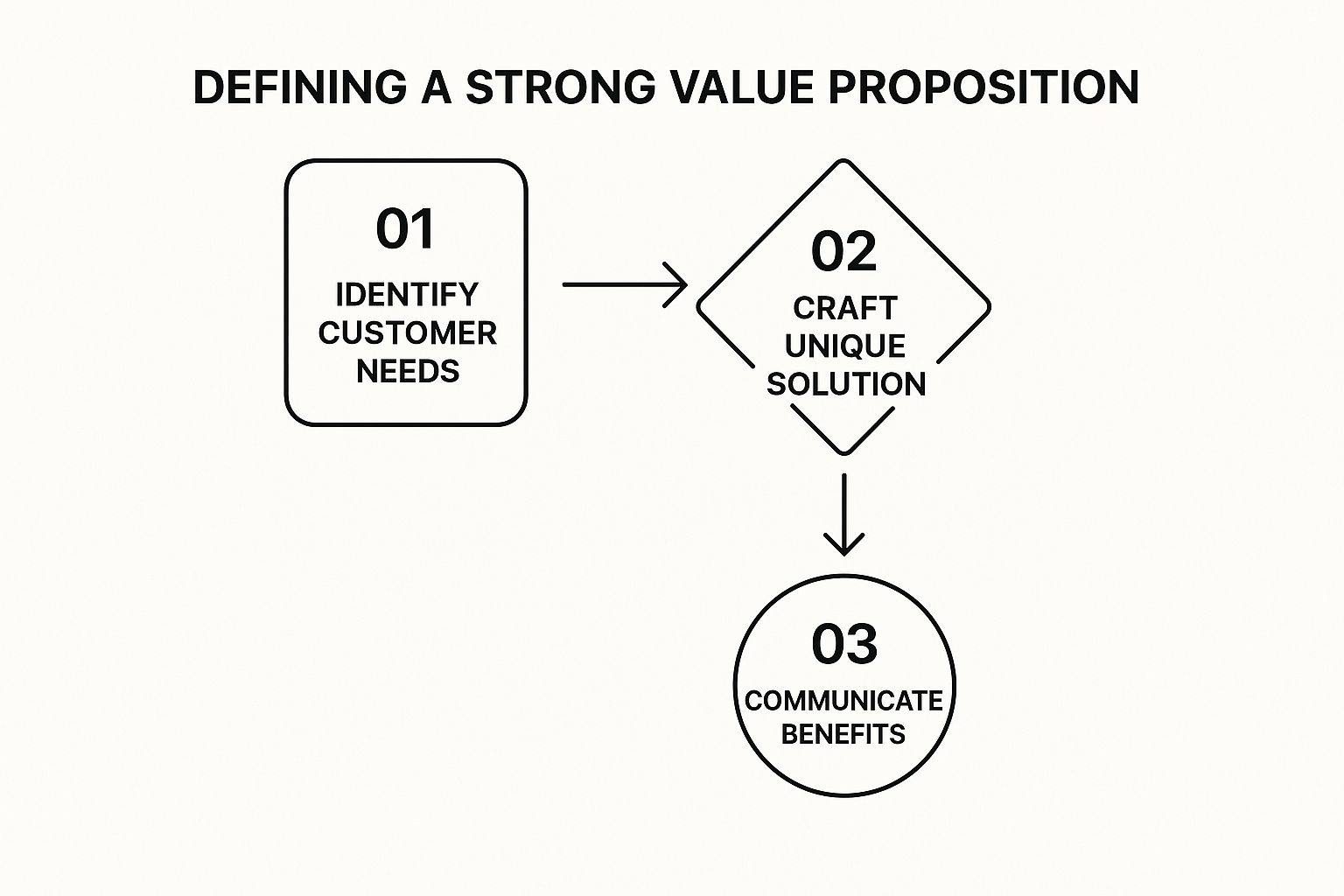Think of a business model canvas template as your entire business on a single sheet of paper. It's a killer strategic tool that helps you map out, design, and pressure-test your big idea without getting lost in the weeds. It takes all the complexity and boils it down to nine core building blocks, giving you a crystal-clear snapshot of your entire operation.
Why the Business Model Canvas Matters Now

Let’s be real. The world moves fast. That dusty 60-page business plan you spent months writing? It’s probably out of date before the ink is even dry.
This is where the Business Model Canvas (BMC) comes in. Dreamed up by Alexander Osterwalder, it’s a dynamic, visual way to think about your business. It’s less of a static document and more of a strategic conversation—one that cuts through the noise and brings everyone onto the same page.
I like to think of it as the ultimate roadmap for your company. When you can see every critical piece of the puzzle laid out in one place, you start to spot the connections. You see the weak spots. You uncover opportunities you never would have noticed otherwise. It’s a game-changer for getting teams aligned and moving in the same direction.
If you’re looking to really level up your planning game, weaving the BMC into your broader workflow is a smart move. There's a ton of great info out there on Digital Planning for Peak Productivity that can help you connect the dots.
From Hazy Idea to Actionable Plan
The real magic of a business model canvas is how it turns those "what if" ideas into a solid, workable plan. It’s built for a lean approach, which means startups can pivot on a dime and established companies can innovate without getting bogged down in endless paperwork.
It's no surprise that the BMC has become a go-to tool for strategists everywhere. By 2016, it had already been downloaded over 5 million times across the globe. That’s a massive testament to its value, whether you're in a garage startup, a Fortune 500 company, or even a university classroom.
The canvas forces you to have the tough conversations right from the start. Who are our customers, really? What value are we actually delivering? And, the big one: how are we going to make money? Getting that foundational clarity is what separates the businesses that thrive from those that just fizzle out.
Understanding the Nine Building Blocks
The Business Model Canvas is built around nine essential components. These blocks are designed to cover the four pillars of any business: your customers, what you offer them, the infrastructure you need to deliver it, and how you'll stay financially viable. Each block forces you to answer a fundamental question, giving you a complete 360-degree view of your model.
Here’s a quick overview of the nine building blocks that make up the Business Model Canvas. Each one asks a crucial question that gets to the heart of how your business will function and succeed.
| Building Block | Core Question It Answers |
|---|---|
| Customer Segments | Who are you creating value for? |
| Value Propositions | What problem are you solving or need are you fulfilling? |
| Channels | How do you reach your customers? |
| Customer Relationships | What kind of relationship do you have with your customers? |
| Revenue Streams | How does your business earn revenue? |
| Key Activities | What are the most important things your business must do? |
| Key Resources | What essential assets are required to make your model work? |
| Key Partnerships | Who are your key partners and suppliers? |
| Cost Structure | What are the most important costs in your business model? |
When you put them all together, these blocks don't just give you a checklist—they give you a powerful, yet surprisingly simple, framework for building and innovating.
Building Your Operational Backbone
Okay, so you’ve got a solid handle on your customer and the killer value you're bringing to the table. Now it's time to flip the canvas over, so to speak. We're moving from the "who" and "what" to the all-important "how." This is where you get into the nitty-gritty, mapping out the internal machinery that actually makes your business run.
We’re talking about the left side of the business model canvas: Key Partnerships, Key Activities, and Key Resources. This trio forms the operational backbone that holds everything else up.
If your value proposition is the engine, think of these three blocks as the chassis, the fuel, and the transmission. They’re the guts of the operation—the essential pieces you need to build your product, get it to your customers, and keep the whole thing humming.
Let's break down how to map out this critical infrastructure.
Pinpointing Your Key Activities
First up, Key Activities. These are the absolute most important things your company must do to make your business model work. This isn’t about the day-to-day busywork or administrative tasks. We're talking about the core actions that directly create and deliver your value proposition, connect with your customers, and, of course, make you money.
For a SaaS company, a non-negotiable key activity is software development and maintenance. For your neighborhood coffee shop, it’s all about brewing amazing coffee and delivering a fantastic customer experience. Simple as that.
To nail yours down, ask yourself a few direct questions:
- What are the handful of things we absolutely have to do to even have a product or service?
- Which actions are make-or-break for keeping our customer relationships strong?
- What are the core tasks that actually drive our revenue streams?
Getting a handle on these activities is everything. For anyone juggling a million different project threads, checking out some of the best freelance project management tools can be a game-changer for keeping these core operations from going off the rails.
This flow chart really drives home how your key activities are the bridge between a customer's problem and your solution.

As you can see, your core activities have to be laser-focused on crafting and communicating the benefits of what makes you unique.
Identifying Your Key Resources
Next, you've got to figure out your Key Resources. These are the mission-critical assets you need to pull everything off. Think of them as the fundamental ingredients your business needs to function—the physical, intellectual, human, and financial building blocks.
A freelance graphic designer’s key resources would be their design software (intellectual), a beefy computer (physical), and their own creative talent (human). A food delivery service, on the other hand, is dead in the water without its fleet of vehicles, its routing software, and its team of drivers.
Don’t just make a laundry list of every single thing you own. The key is to focus on the assets that are strategically vital for you to compete and deliver value. A patent, a proprietary algorithm, or a uniquely talented team—those are the kinds of key resources that give you a real edge.
Forging Key Partnerships
Finally, remember that no business is an island. Key Partnerships represent the network of suppliers and partners you rely on to make your business model work. These aren't just any vendors; they are strategic relationships you build to reduce risk, acquire specific resources, or simply run a more efficient operation.
Take a boutique clothing shop. A key partnership might be with a local designer for exclusive pieces that no one else has, or a rock-solid shipping company that guarantees on-time delivery. These alliances are more than just transactions—they're a core part of your competitive advantage.
Who do you absolutely need in your corner to deliver on the promise you've made to your customer? That's your answer.
2. Value Proposition: The Heart of Your Business

If your business model canvas template were a solar system, your Value Proposition would be the sun. Seriously, everything else revolves around it.
This block is so much more than a snappy marketing slogan; it’s the fundamental promise you make to your customers. It answers the single most important question they'll ever ask: "Why should I choose you?"
Think about the brands that just get it. Airbnb isn't just selling you a place to stay; they're offering the chance to "belong anywhere." Slack doesn't just sell a chat app; they sell streamlined communication and "organizational productivity." Your goal here is to nail down the unique value you deliver with that same laser-like focus.
This central block really is the anchor that connects every other part of your canvas. A strong value proposition makes it crystal clear who your customers are, how you’ll reach them, and what activities are absolutely essential to your success.
From Pain Point to Promise
The most powerful value propositions I've ever seen are born from a deep, almost obsessive, understanding of customer pain points. What’s the nagging problem, the unmet need, or the frustrating inefficiency that keeps your target audience up at night?
Your solution needs to hit that pain point head-on. This isn't about listing features—it's about the benefits and outcomes people get.
To get the ball rolling, ask yourself these questions:
- What specific problem are you solving? Be brutally precise. "Saving time" is vague. "Reducing meeting prep time by 50%" is a value proposition.
- How do you uniquely solve it? This is your secret sauce. Checking out some unique selling proposition examples can be a great way to see how other brands carve out their niche.
- What are the tangible benefits for the customer? Always frame it from their perspective. Will they save money, slash their stress levels, or gain a new superpower?
Getting this part right is absolutely essential for your messaging and, down the line, for figuring out how to build a brand strategy that truly connects with people.
Your Value Proposition should be so clear that a potential customer gets it instantly. If you have to explain it for five minutes, it isn't strong enough. You're aiming for that gut-level "aha!" moment.
Every other block on your canvas is there to support and deliver on this core promise. Nail this, and you've built a rock-solid foundation for a business that can go the distance.
You've nailed down the heart of your business—your Value Proposition. Awesome. Now it's time to turn your attention to the people you're actually building this for.
This is where we get to shift to the right side of the business model canvas, the side that's all about your customers. We’re talking about who they are, how you're going to reach them, and what kind of relationship you want to build.
These three blocks—Customer Segments, Channels, and Customer Relationships—are totally connected. Getting them right isn't about slapping generic labels on a chart; it's about building a powerful, customer-facing strategy that feels genuine and just plain works.
Who Are Your Customer Segments?
Your Customer Segments block is where you get brutally honest about who you're serving. "Small businesses" or "young professionals"? That’s not going to cut it. It’s way too broad.
The real goal here is to pinpoint distinct groups of people or organizations who share common needs, behaviors, or other defining traits.
Are you playing in the mass market, like a toothpaste brand trying to sell to everyone? Or are you focused on a niche market, like a company that makes custom hiking gear for professional alpinists?
Plenty of businesses serve several segments at once. Think about a bank. They have completely different products and services for students, high-net-worth individuals, and small business owners. Each of those groups has its own unique problems and needs a totally different approach.
To get your head around this, think about these common archetypes:
- Mass Market: Your product is for a huge, broad audience with similar needs.
- Niche Market: You're all-in on a specific, specialized customer segment with very particular demands.
- Segmented: You see differences between market segments with slightly different needs, and you cater to them.
- Diversified: You serve two or more completely unrelated customer segments with wildly different needs.
Drilling down into these segments is the first real step toward building a marketing plan that actually connects with people. Honestly, a deep understanding of your audience is the cornerstone of any successful outreach, and you can see how this knowledge translates into action by exploring more effective small business marketing strategies for growth.
Defining Your Customer Relationships
Okay, so you know who you’re talking to. The next big question is: what kind of relationship will you have with them? And no, I don't mean becoming best friends. This is a strategic decision that directly impacts the customer experience and, ultimately, your bottom line.
A high-end consulting firm, for example, will almost certainly offer dedicated personal assistance. Every client gets a single point of contact. On the flip side, a self-service SaaS platform might lean on automated services and online communities where users can help each other out.
The relationship you choose has to line up with what your customer segment expects and what makes sense for your business model. A budget airline's customers don't expect white-glove service, but a luxury hotel's guests absolutely do. Mismatching these expectations is a recipe for disaster.
Choosing Your Channels
Last but not least, your Channels are all the touchpoints where you interact with your customers. This block maps out how you communicate with and reach your Customer Segments to deliver on your Value Proposition. Think of it as the entire customer journey, from "hello" to "here's your stuff."
Channels have several distinct phases you need to think through:
- Awareness: How do people even find out you exist?
- Evaluation: How do you help customers decide if you're the right choice?
- Purchase: How do they actually buy from you? Is it easy?
- Delivery: How do you get your product or service into their hands?
- After Sales: What happens after the purchase? How do you provide support?
Your channels can be your own (like your website, social media, or a direct sales team) or they can be partner channels (like wholesale distributors, affiliates, or retail stores). The real key here is creating a seamless, consistent experience across every single touchpoint.
An amazing idea is just a hobby until it can sustain itself.
Now we get to the financial foundation of your business model canvas template—the two blocks that determine if your vision is actually viable: Cost Structure and Revenue Streams.
This is where the rubber really meets the road. You can have the most compelling value proposition and the happiest customers on the planet, but if the numbers don't add up, the entire structure will eventually collapse.
Let's break down how to map out the economics of your business so that doesn't happen.
Unpacking Your Cost Structure
Your Cost Structure is where you'll outline all the expenses required just to keep the lights on and operate your business. This isn’t just about making a list of bills; it’s about understanding the financial DNA of your entire model.
A good way to start is by separating your costs into two main buckets.
- Fixed Costs: These are the expenses that stay the same no matter how much you sell. Think of things like rent for your office, employee salaries, and those monthly software subscriptions.
- Variable Costs: These costs fluctuate directly with your sales volume. A few classic examples are the raw materials for a product, transaction fees from your payment processor, or performance-based ad spend.
Once you’ve got your expenses categorized, you can start to see what kind of model you're building. Are you cost-driven, like a budget airline that obsesses over shaving every last penny off its operating expenses to offer the lowest price? Or are you value-driven, like a luxury watch brand where premium materials and exceptional service are baked right into a high-end cost structure?
Neither is better than the other; they just serve completely different strategies.
Designing Your Revenue Streams
Next up is the fun part: figuring out how you’ll make money. Your Revenue Streams block details all the different ways your business generates cash from each customer segment. A common mistake I see is founders only thinking about one-time sales, but the possibilities are so much broader than that.
This is your chance to get creative. Could a subscription model provide more predictable, recurring income? Would licensing your intellectual property make sense down the line?
Think about some of these common models:
- Asset Sale: The most straightforward approach—selling ownership rights to a physical product.
- Usage Fee: Customers pay based on how much they use a service, kind of like a cell phone plan.
- Subscription Fees: A recurring fee for continuous access, which is super common for SaaS or media content.
- Licensing: Giving customers permission to use your protected intellectual property in exchange for a fee.
- Advertising: Earning revenue by selling ad space to other businesses.
A great business model canvas template forces you to think systematically about these components. Case studies show time and again how this visual layout cuts through the complexity and guides founders in addressing critical elements like revenue and costs. This structured approach is a key reason the BMC is so praised for helping plan and scale new ventures; you can even see how Google's business model canvas has been analyzed in this way.
Profit isn't just revenue minus costs. It's the strategic interplay between the value you create, the price customers are willing to pay, and the efficiency of your operations. Your canvas should tell this financial story clearly.
Ultimately, your revenue streams have to be directly tied to your value proposition and customer segments. If you’re targeting a budget-conscious audience, a high-end subscription model probably isn't going to fly.
Success here also depends on tracking what works. You can find some excellent advice for measuring marketing effectiveness to make sure your revenue-generating activities are actually hitting the mark.
By carefully balancing your Cost Structure and Revenue Streams, you’re not just building a business—you’re building a sustainable engine for growth.
A Few Common Questions About the Canvas

Once you start using the canvas, a few practical questions almost always pop up. Trust me, I've seen it happen time and time again. Getting clear on these from the get-go will help you get so much more out of the tool.
How Often Should I Update My Canvas?
Think of your canvas as a living, breathing document. It’s not meant to be framed and hung on the wall.
In the early days of a startup, you might be tweaking it weekly. Seriously. Every piece of customer feedback, every tested assumption, is a reason to revisit it. The name of the game is rapid iteration.
For a more established business, a quarterly review is a pretty solid rhythm. It’s enough to keep you honest and adapt to market shifts, new tech, or weird changes in customer behavior. The point is to treat it as a dynamic strategy tool, not a one-and-done assignment you file away.
A business model canvas is not a "set it and forget it" exercise. It's a snapshot in time. As the market landscape changes, so should your canvas. Regular updates ensure your strategy stays relevant and responsive.
Canvas vs. a Traditional Business Plan
This is a big one, and a source of a lot of confusion. The Business Model Canvas and a traditional business plan aren't enemies; they just have different jobs. The canvas is for exploration, quick pivots, and getting your team on the same page. The business plan is for detailed execution and formal presentations—think banks and investors.
Here’s a simple way to look at it:
| Aspect | Business Model Canvas | Traditional Business Plan |
|---|---|---|
| Purpose | Strategy & Innovation | Execution & Fundraising |
| Format | Visual, one-page summary | Detailed, multi-page document |
| Flexibility | High (easy to change) | Low (hard to update) |
| Use Case | Brainstorming, testing ideas | Securing loans, detailed planning |
Basically, the canvas is your strategic sketchbook. The business plan is your formal blueprint. They’re complementary, not competitors.
Can I Use the Canvas for a Non-Profit?
Absolutely. The canvas is incredibly flexible and works great for non-profits. The building blocks just take on a slightly different flavor.
For example, your “Customer Segments” might become “Beneficiaries” on one side and “Donors” on another. Your “Revenue Streams” would include things like grants, individual donations, and fundraising events. The core logic—creating and delivering value to specific groups—is exactly the same. It's a powerful way to map out a sustainable impact model.
What are the Common Mistakes to Avoid?
It’s easy to fall into a few common traps when you’re new to this. A little heads-up can save you a ton of frustration.
- Being too vague. Don't just write "marketing." Get specific. "Content marketing via blog posts targeting SEO keywords" is way more useful.
- Working in a silo. The canvas is a team sport. Bringing in people from sales, tech, and customer support will uncover blind spots and make the final model so much stronger.
- Forgetting to test your assumptions. Your canvas is just a collection of your best guesses. You have to get out of the building and validate them. This is a huge part of learning how to validate a business idea before you sink real money into it.
- Treating it as a final plan. Remember, it’s a tool for thinking, not a contract set in stone. Its whole purpose is to guide your strategy, not lock you into a path you can't change.
Ready to find the perfect creative partner to bring your business model to life? Creativize connects you with top local talent for branding, design, animation, and more. Discover vetted creative professionals today.

